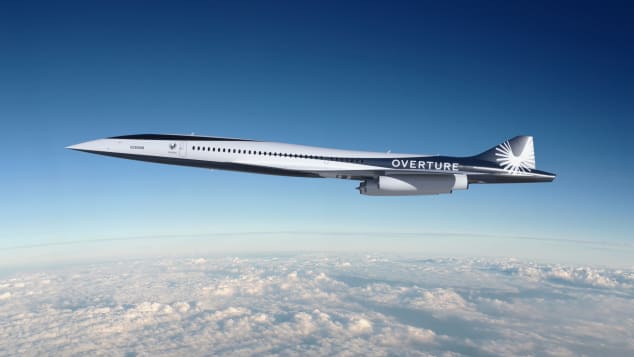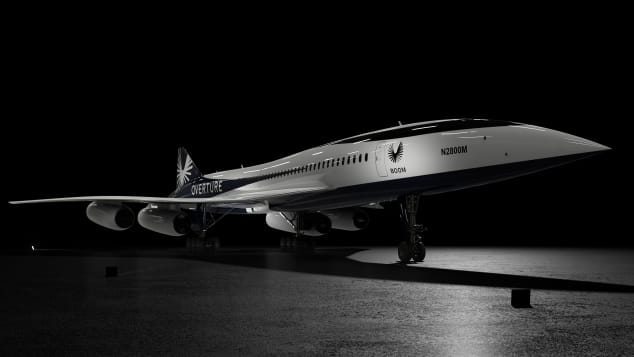Update: ahead of Tuesday’s planned announcement, Jon Ostrower breaks news about the identities of Boom Aerospace engine providers.
Boom looks outside of traditional commercial propulsion for powering supersonic Overture. … Boom is tasking Florida Turbine Technologies, a unit of defense aerospace company Kratos Defense & Security, alone with StandardAero, and a smaller unit of GE Aerospace, according to multiple industry sources.
They couldn’t get any of the big engine manufacturers to bite, because no one thinks this project will succeed commercially. If everyone is wrong, and if the smaller players turn out to have the expertise, this would be a huge win all-around. But probabilities are stacked against success.
Original December 11 post follows:
Last year United Airlines placed an order for Boom Aerospace’s promised Supersonic jets. This summer American Airlines followed suit. Japan Airlines is an investor in the company.
And yet most people in aviation think that the plane will never be built.
- It has a very limited market, relatively short flying range (for an initial plane, at least) and needs to fly overwater due to noise – likely still true even with regulatory changes
- Given the limited market, no major engine manufacturer has seemed willing to step up to make an engine for the plane.
Rolls Royce was supposed to build an engine. They dropped out. GE, Honeywell, and Safran all passed. Pratt & Whitney did too.
However Boom promised to announce an engine manufacturer by the end of 2022. And they’re doing exactly that, on Tuesday. Who could it be? CFM? GE Honda makes regional jet engines. Unless they managed to get a major manufacturer to do an about face after publicly taking themselves out of the running, Boom will still have a credibility challenge.

Credit: Boom Aerospace
An engine manufacturer has to believe that the engine is going to sell well, in order to recoup develop costs and turn a profit. In fact it has to sell better than other things they might deploy development resources against.
The engineering Boom wants to accomplish should be possible. Supersonic jets aren’t a new idea, Concorde accomplished it 50 years ago. They’re just trying to engineer something that’s more fuel efficient – both for operating economics (so airlines can make money) and for environment concerns (airlines have made environmental commitments). They’re also trying to make something quieter.
An engine manufacturer hsa to be not just on Boom Aerospace technology, but on the willingness of airlines to actually buy the planes. That doesn’t just mean place orders for the planes, either!
- No U.S. airline ever purchased a Concorde, though orders were placed by Pan Am, Continental, TWA, American Airlines, Eastern, United and Braniff.
- There were also orders from Qantas, Air India, Sabena, Air Canada, Lufthansa, and even Middle East Airlines and others which never came to fruition.
- Only British Airways and Air France took actual deliveries of new aircraft.
- The only other committed order came from Iran Air, and that was cancelled after the Iranian revolution.
Oddly Braniff did briefly own Concordes for a few hours at a time. They operated service between Dallas and Washington Dulles in conjunction with Air France and British Airways, but to do so they were required to take ownership of the plane for the flight segment in order to operate under their own certificate of airworthiness.
As well as changing flight crews the US approved documentation and procedures had to be present on the flight deck, which meant that the UK/French documentation had to be stored in the forward toilet.
There also had to be a change in the aircraft registration, while being flow on the Dallas – Washington – Dallas routes the “G” or “F” was covered up with white tape. On landing at Washington the ground staff would pull work ladders up to the tail and peel of the F- or G- registration numbers and changed them to an “N” with two letters and the numbers “94″ after that. This was repeated every time the Concordes landed in the US from Europe.

Credit: Boom Aerospace
As long as supersonic travel is more expensive than subsonic, the market will be limited. And the number of city pairs that can work with this plane is limited, too. Limited markets make it tough to recoup development and acquisition costs. Airlines have a hard time making money operating only a couple of planes of a type. The plane needs to be capable of flying long distances, fuel efficiently, and carry large numbers of passengers in order to be economical on a large scale.
Otherwise the market has to be able to support fares significantly higher than for subsonic transport. The ultimate question is: how much is shaving 3.5 hours off of an East Coast transatlantic flight worth, and to how many people?
When American announced their order they said they made a non-refundable deposit but didn’t specify what that means. It could have been $1. They didn’t even produce a graphical rendering of the plane in American Airlines livery. And American didn’t spend the day promoting this on social. For some reason they made the move (claiming to have ordered more planes than United, even) but didn’t go all-out even with the P.R. Their pilots’ union even came out against the move, and they represent the people who theoretically would get to fly the thing!
It’s possible to build a supersonic plane, but inefficiencies and regulation killed the Concorde. Boom can presumably develop a plane, and a top engine manufacturer can produce an engine for it. But will it sell to airlines who see themselves able to operate enough of the planes, to enough places, with enough frequency – given a market that will pay a premium for the option – in order to buy enough planes and engines where the whole thing works out as a business?
We’ll see what tier of engine manufacturer they’ve convinced to make a bet that they can – and how real the commitment is. Boom has raised about $250 million in funding over the past 8 years. That’s real money but not close to enough to guarantee an engine manufacturer recoups their costs.
Engines can run billions of dollars to design and tens of millions of dollars apiece to purchase. It’s a huge bet for a manufacturer which would need to sell large numbers of engines just to break even. If a manufacturer can’t sell several hundred engines they won’t recoup their development cost, after recouping production costs, let alone turn the project profitable.
(HT: @jonostrower)


It’s all going to come down to money . . . can it get operational costs down to anywhere near (say) 12 cent per passenger mile? Given prior articles and prior comments, we don’t need to rehash that discussion. I think the project is fundamentally flawed and, if it flies, I don’t see it being adopted in a big way.
@Gary: Nobody has really ordered this thing yet. AA and UA can both get out scott free when it isn’t built. The “non refundable deposit” just referred to the unlikely case that everything went to plan and AA had a change of heart.
The obvious backer would be Elon Musk. Aside from the instant credibility it would give the project it would also begin a process of steadlity longer range and capacity.
L3, no offense intended, the expression is scot free (one “t”). It is a shortening of scutage, which was a payment owed from a vassal to a lord.
Good luck to Boom, they will need it.
@Lee: With a hyphen apparently.
https://www.merriam-webster.com/dictionary/scot-free
Jeepers. I hope it isn’t NPO-Saturn.
https://en.m.wikipedia.org/wiki/UEC_Saturn
IT’S OUT! Vibe just released the name
https://www.briggsandstratton.com/na/en_us/home.html
No reason why planes can’t fly faster and without pilots. The planes of today are basically the same as 60 years ago except with worse service and seats and overall much less pleasant. Seems like a market ripe for innovation if the regulators just got out of the way.
Their Overture project looks DOA. Europe is stagnating and becoming anti-innovation, and the only airports they can realistically go trans-Atlantic over water are London and Paris. with operational range less than 5k miles they cannot really go trans-Pacific. They probably can do LAX-HNL-HND, but what the point to do refueling stop and kill the only advantage they have. In theory they can do HND/PVG/HKG-SYD nonstop, but that about it- they cannot even do HNL-SYD. And because of their overwater limitations they cannot really go fast to DXB or SIN where the money are.
So instead they are shooting for government and military funding at least this is what they say right on first page of their site. Good luck with getting taxpayer money 🙂
Ka Boom!
Jerry,
You seemingly haven’t paid close attention when adverse weather induced runway changes are made . It’s almost all on the pilots to replan the new approach or departure courses to fit within the time frame for the runway changes. Adverse turbulence? Most autopilots disengage when the turbulence exceeds certain limits, since autopilots are notorious for damaging aircraft if left alone to slam the flight controls to the limits trying to counter turbulence effects. There are a lot of scenarios where having a human pilot in the loop is advantageous.
IF the Boom aircraft can be flown supersonically with a significantly reduced overpressure shockwave compared to what the Concorde had then overland supersonic flight might be approved. Supposedly that was one of the goals of the designers and engineers.
Is this true or more speculation? What a shock that this engine is, so far, top secret. I still wish this were true. There has been no innovation in flight speed in the commercial segment in over half a century. Time is ripe for that to change. Again, we’ll see when/if the new engine is announced and than comes to fruition. Keep the dream alive.
@David M Hoffman Except nothing about their design would accomplish that? It’s essentially just a scaled down Concord, so the namesake “boom” is going to be just as prevalent. Honestly, I had my doubts the moment they named the company Boom. So the moniker is the same as the one major regulatory/PR hurdle they need to overcome/downplay? Hope they didn’t pay those marketing consultants much…
To coattail on Joking J, the FAA would require a sonic boom to be no more than about 37 decibels at ground level. The current state of the art airframe designs are still in the high 40s decibel zone. I think over-land supersonic is not happening (yet).
The higher likelihood is hypersonic trans-atmospheric flight. No boom. Engines under development. But, further out in time.